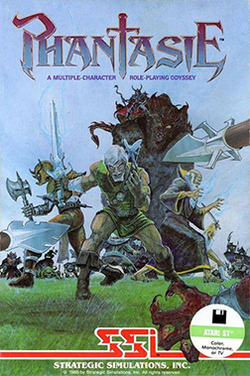Software:Phantasie
| Phantasie | |
|---|---|
 | |
| Developer(s) | Strategic Simulations |
| Publisher(s) | Strategic Simulations |
| Designer(s) | Winston Douglas Wood |
| Writer(s) | Winston Douglas Wood |
| Series | Phantasie |
| Platform(s) | Apple II, Commodore 64, MS-DOS, Atari 8-bit, Atari ST, Amiga, MSX, FM-7, Sharp X1, PC-98 |
| Release | 1985 |
| Genre(s) | Role-playing |
| Mode(s) | Single-player |
Phantasie is the first video game in the Phantasie series.
Gameplay
Based on the Isle of Gelnor, Phantasie allows a group of six characters to adventure the countryside and try to defeat the evil Black Knights and their sorcerer leader, Nikademus. Players could choose to be one of six character classes (Thief, Fighter, Ranger, Monk, Priest, and Wizard) and could also choose between the races of Human, Dwarf, Halfling, Elf, or Gnome. By selecting "Random" one could also choose from ogre, troll, pixie, gnoll, orc, lizard man, minotaur, and other races.
The game was notable for taking advantage of a broad mix of styles for the game: a town window which allowed purchasing in various shops, a top-down style dungeon crawl view, a top-down world map, and a separate combat window. Each character class had unique fighting styles and options and all characters could choose their strategy for a particular round in the turn-based combat segments. After a combat, experience was awarded, but the players would have to return to town to purchase their levels if they qualified.
Reception
With more than 50,000 copies sold in North America, Phantasie was very successful for SSI.[1] It was the company's best-selling Commodore game as of late 1987.[2] Game reviewers Hartley and Pattie Lesser in 1987 complimented the Atari ST version of Phantasie in their "The Role of Computers" column in Dragon #120 (1987), recommending that Atari ST owners should "consider Phantasie as a game well-worth their attention".[3] ANALOG Computing in 1988 called Phantasie and its sequel the best fantasy role-playing games for the Atari 8-bit.[4] In 1991 and 1993 Computer Gaming World's Scorpia called Phantasie "a surprisingly good little game, with many interesting features".[5][6]
Development
When interviewed about the inspiration of the game Wood stated "I had played Wizardy and Ultima. They convinced me that computers were ideal for RPG’s. I also played D&D and another tabletop game called RuneQuest. The basic mechanics of combat and character development were inspired by RuneQuest."[7]
Wood also discussed the inspiration behind the character of Nikademus, "I had certainly read Tolkien and studied Greek mythology and culture. I had also read The Chronicles of Narnia and other fantasy novels. I didn’t intentionally try to draw from any one source; I just used elements that I liked. I felt that I succeeded on the whole. The way these elements came together to create the worlds of Phantasie was one of its strengths. Nicodemus was a character from the book Mrs. Frisby and the Rats of NIMH. I thought it sounded like a great bad-guy name but I realized it was also the name of a Biblical character. I felt I should change the spelling and thus my character became Nikademus."[8]
Reviews
Legacy
Phantasie I, Phantasie III, and Questron II were later re-released together, and reviewed in 1994 in Dragon #203 by Sandy Petersen in the "Eye of the Monitor" column. Petersen gave the compilation 2 out of 5 stars.[12]
References
- ↑ Maher, Jimmy (2016-03-18). "Opening the Gold Box, Part 3: From Tabletop to Desktop". The Digital Antiquarian. http://www.filfre.net/2016/03/opening-the-gold-box-part-3-from-tabletop-to-desktop/. Retrieved 19 March 2016.
- ↑ Ferrell, Keith (December 1987). "The Commodore Games That Live On And On". Compute's Gazette: pp. 18–22. https://archive.org/stream/1987-12-computegazette/Compute_Gazette_Issue_54_1987_Dec#page/n17/mode/2up. Retrieved 24 January 2015.
- ↑ Lesser, Hartley; Lesser, Patricia (April 1987). "The Role of Computers". Dragon (120): 79–82.
- ↑ Panak, Steve (September 1988). "Panak Strikes". ANALOG Computing: pp. 83. http://www.atarimagazines.com/analog/issue64/panak.php. Retrieved 30 January 2015.
- ↑ Scorpia (October 1991). "C*R*P*G*S / Computer Role-Playing Game Survey". Computer Gaming World: 16. http://www.cgwmuseum.org/galleries/index.php?year=1991&pub=2&id=87. Retrieved 18 November 2013.
- ↑ Scorpia (October 1993). "Scorpia's Magic Scroll Of Games". Computer Gaming World: 34–50. http://www.cgwmuseum.org/galleries/index.php?year=1993&pub=2&id=111. Retrieved 25 March 2016.
- ↑ https://rpgcodex.net/content.php?id=8786
- ↑ https://rpgcodex.net/content.php?id=8786
- ↑ "Ludotique | Article | RPGGeek". https://rpggeek.com/rpgissuearticle/139195/ludotique.
- ↑ "Jeux & stratégie 35". October 1985. https://archive.org/details/jeux-et-strategie-35/page/48/mode/2up.
- ↑ "GAMES Magazine #70". December 1985. https://archive.org/details/games701985december/page/n51/mode/2up.
- ↑ Petersen, Sandy (March 1994). "Eye of the Monitor". Dragon (203): 59–62, 69.
External links
- Review in ANALOG Computing
- Review in ANALOG Computing
- Review in Family Computing
- Review in Compute!'s Gazette
- Review in Info
 |


